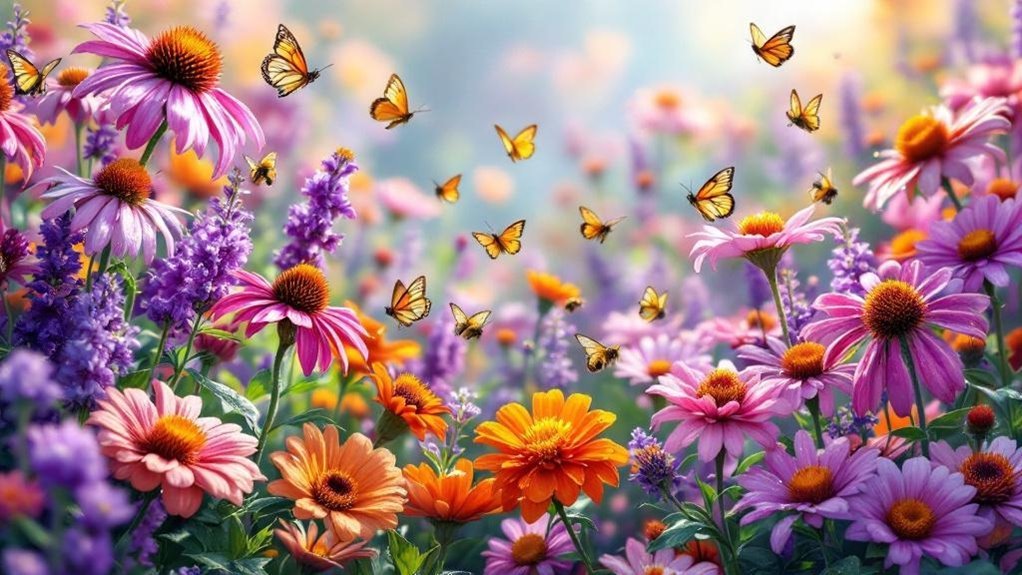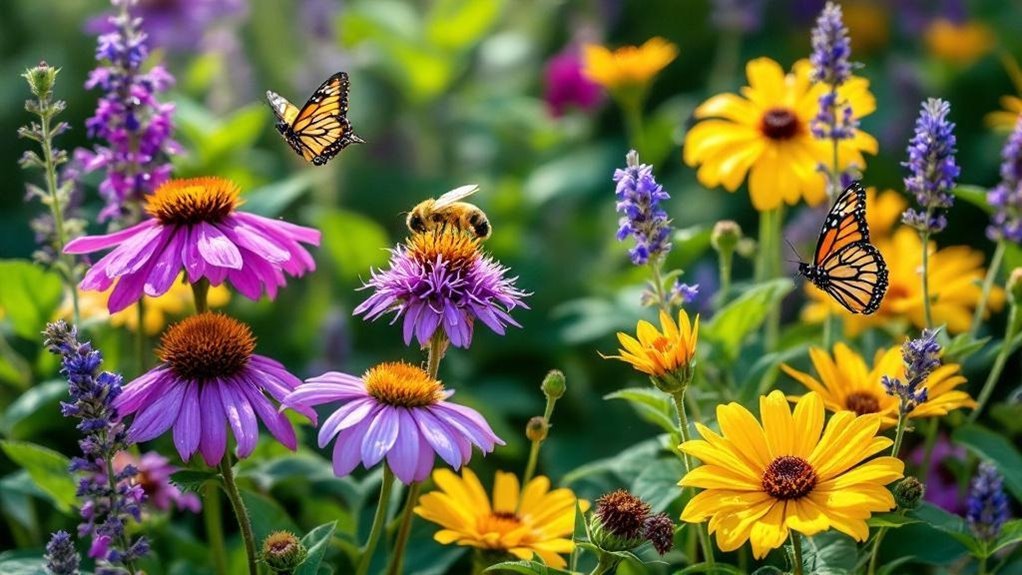Did you know that nearly 75% of the world’s flowering plants depend on pollinators like bees and butterflies? If you want to support these essential insects, choosing the right flowers is key. Certain plants not only provide nectar but also create habitats that encourage pollinator visits throughout the season. Understanding which flowers work best and how to arrange them can make all the difference in your garden’s success.
Top Flower Choices for Attracting Bees
Five standout flowers can help you attract bees to your garden, each offering vibrant colors and nectar-rich blooms.
Helenium’s bright gold and red petals bloom throughout summer to fall, making it a top choice among flowers for pollinators.
Achillea (Yarrow) thrives in full sun and is drought-tolerant, providing nectar and pollen from mid-spring through fall.
Rudbeckia, with its dark centers, attracts bees and butterflies from mid-summer to fall.
Echinacea (Coneflower) supports pollinator-friendly plants and delivers long-lasting cut flowers while thriving in various light conditions.
Coreopsis, easy to grow from seeds, blooms from summer through fall with warm, inviting colors.
These perennial flowers not only attract bees and butterflies but also guarantee your garden stays lively and pollinator-friendly all season long.
Best Plants to Draw Butterflies
If you want to create a vibrant butterfly garden, planting nectar-rich flowers like Echinacea and Achillea will attract a variety of butterflies with their colorful blooms and accessible pollen.
To draw even more pollinators, include plants like Cosmos and Coreopsis, which thrive in full sun and offer abundant nectar.
Plant sun-loving Cosmos and Coreopsis to boost your garden’s nectar supply and attract more pollinators.
Don’t forget native milkweed—essential for attracting monarch butterflies, as it serves as a host for their larvae.
Adding Monarda with its tubular flowers enhances your garden’s appeal by attracting both butterflies and hummingbirds.
For a diverse array of pollinators, include Rudbeckia and Aster to guarantee a continuous supply of nectar throughout the season.
Combining Flowers for Continuous Bloom

To keep your pollinator garden vibrant all season, combine flowers that bloom at different times. Start with early bloomers like Echinacea to attract pollinators in spring, then add mid-season favorites such as Rudbeckia, followed by late bloomers like Helenium for continuous blooms.
Plant clusters of at least three of each species to provide ample nectar and pollen. Incorporate a variety of flower shapes and colors—tubular Agastache flowers appeal to hummingbirds, while flat-topped Yarrow attracts bees—so you attract a variety of pollinators.
Include versatile plants like Coreopsis and Monarda that bloom from summer through fall, ensuring your pollinator garden stays lively. By thoughtfully combining flowers, you create a rich, staggered flowering timeline that supports pollinators all season long.
Creating a Pollinator-Friendly Garden Habitat
When you create a pollinator-friendly garden habitat, you invite a variety of bees, butterflies, and other beneficial insects to thrive.
To attract and support pollinators effectively, focus on these key elements:
- Plant flowers in a variety native to your area, including Best Pollinator Plants like Helenium, Achillea, and Echinacea, to provide nectar and pollen throughout the growing season.
- Include water sources such as shallow bowls with pebbles or muddy puddles, ensuring pollinators stay hydrated and get vital nutrients.
- Provide shelter by leaving some garden areas wild or adding nesting boxes for solitary bees, creating safe spaces for pollinator populations.
Native Plants That Support Local Pollinators

Because native plants have evolved alongside local pollinators, they offer the most effective sources of nectar and pollen. By choosing native plants like Achillea and Rudbeckia, you provide crucial food sources that support local pollinators, including bees and butterflies.
These flowers that attract beneficial insects thrive in pollinator gardens, enhancing biodiversity and garden sustainability. Plus, native perennials such as Echinacea and Aster bloom at different times throughout the growing season, ensuring continuous nourishment for pollinators.
Native perennials like Echinacea and Aster bloom sequentially, supporting pollinators and boosting garden biodiversity.
Incorporating drought-tolerant natives like Monarda and Agastache means you’ll enjoy low-maintenance beauty while attracting beneficial insects year-round.
When you plant native species, you create a vibrant habitat that supports local pollinators effectively, helping restore healthy pollinator communities in your area.
Benefits of Planting Perennials for Pollinators
Perennials play a vital role in supporting pollinators by offering continuous blooms from mid-spring through fall, ensuring butterflies and bees have a steady food source throughout their active seasons.
When you plant perennials, you’re attracting beneficial insects with abundant nectar and pollen, making your garden a pollinator favorite. Plus, these plants often require less care, being low-maintenance and drought-tolerant.
Here’s why perennials are a smart choice:
- They bloom attract pollinators over several months, providing critical food.
- Deep roots improve soil health and sustain local biodiversity.
- Many self-sow, creating lasting habitats for pollinators year after year.
Using Herbs to Attract Beneficial Insects
Adding herbs to your garden can boost its appeal to beneficial insects like bees and butterflies.
Flowering herbs such as basil, dill, and cilantro attract bees and butterflies by offering essential pollen and nectar. Anise hyssop’s blue-purple blooms are especially popular with pollinators, while bee balm’s colorful flowers not only attract butterflies but also help repel mosquitoes.
Incorporating herbs like oregano and thyme provides continuous sources of nectar and pollen, supporting these insects through their lifecycle stages.
When you create a garden with a variety of flowering herbs, you encourage biodiversity and support a thriving ecosystem.
How Flower Color and Shape Influence Pollinator Visits
When you choose flowers for your garden, their color and shape play a key role in attracting pollinators like bees, butterflies, and hummingbirds.
Choosing flower color and shape is essential for attracting pollinators like bees, butterflies, and hummingbirds to your garden.
Bright flower colors such as pink, orange, red, and purple catch the eye of these pollinators searching for nectar sources. The shape matters too: tubular flowers suit hummingbirds’ long bills, while flat flowers make nectar accessible for bees and butterflies.
To maximize visits, focus on:
- Selecting single blooms over double blooms for easier access to nectar sources.
- Incorporating tubular flowers like Agastache and Monarda for hummingbirds.
- Using mass planting of flat flowers like Coreopsis and Sunflowers to boost visibility and attract more pollinators.
Tips for Maintaining a Healthy Pollinator Garden
To keep your pollinator garden thriving, you’ll want to provide a diverse mix of nectar- and pollen-rich flowers that bloom throughout the growing season.
Choose plants like Echinacea, Coreopsis, and Monarda to attract pollinators to your garden consistently. Use well-draining, nutrient-rich soil to support healthy growth, and regularly feed plants with quality fertilizer to boost blooms.
Incorporate a variety of flower shapes and colors to appeal to different pollinator species, ensuring easy access to nectar.
Don’t forget to maintain some wild space in your garden to offer shelter and nesting opportunities for beneficial insects like ground-nesting bees.
Frequently Asked Questions
What Flower Attracts Bees and Butterflies?
You’ll find that planting Echinacea or Rudbeckia will attract bees and butterflies easily. Their bright, nectar-rich blooms are irresistible to pollinators, so you’ll enjoy vibrant, buzzing activity in your garden throughout the seasons.
Which Flowers Are Butterflies Most Attracted To?
You might think butterflies prefer only bright flowers, but they’re drawn to nectar-rich plants like Echinacea and milkweed. Choose flat, open blooms like daisies and sunflowers to help butterflies easily access nectar and thrive in your garden.
What Is the Most Attractive Flower for Bees?
You’ll find Echinacea the most attractive flower for bees because it offers abundant nectar and pollen. Planting these in clusters boosts their appeal, helping you support bees effectively in your garden.
What Flowers Are Good for Bees and Hummingbirds?
You’ll want to plant Agastache and Monarda; their vibrant tubular blooms attract both bees and hummingbirds. Hardy Fuchsia is another great choice, blooming late spring through fall and thriving in various light conditions.
Final Thoughts
By planting vibrant blooms like Echinacea, Cosmos, and native milkweed, you’ll create a buzzing, fluttering symphony in your garden. Each flower acts as a nectar beacon, inviting bees and butterflies to dance through your space from spring to fall. With thoughtful choices and care, your garden becomes a living masterpiece—teeming with life, color, and sweet pollinator magic. So grab your gloves and watch nature’s tiniest artists paint your garden with wings and whispers.
